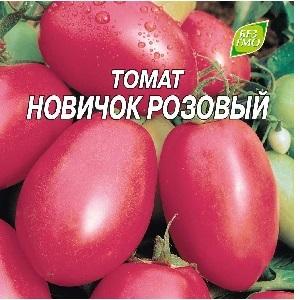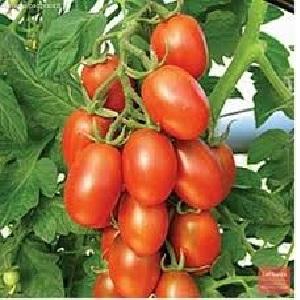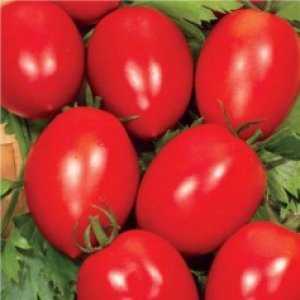One of the best varieties for canning is the early-ripening and high-yielding tomato “Novichok”
The Novichok tomato, due to its high yield and unusual shape, arouses constant interest among summer residents. Many people love this particular variety of tomatoes and for good reason. It is famous not only for its productivity, but also for its extreme ease of care: an ideal variety for beginning gardeners.
Novichok tomatoes are resistant to diseases, unpretentious to watering and in the place of planting. Moreover, the fruits of these tomatoes have a special taste and aroma and perfectly complement any holiday table. They are also great for canning. In this article, we offer you a description of the Novichok tomato variety, step-by-step instructions on how to properly prepare the seeds for planting, how to care for the sprouts and harvest your own homemade tomato crop.
Tomato Novichok characteristics and description of the variety
 The distinctive features of the variety are the compactness of the plant, but at the same time the large size of the fruits. The Novichok bush does not grow more than 80 cm, which allows you to grow these tomatoes at home: on loggias and balconies. Tomatoes ripen within 115 days after sprouting - the variety has a medium-early ripening period.
The distinctive features of the variety are the compactness of the plant, but at the same time the large size of the fruits. The Novichok bush does not grow more than 80 cm, which allows you to grow these tomatoes at home: on loggias and balconies. Tomatoes ripen within 115 days after sprouting - the variety has a medium-early ripening period.
When the fruit acquires a bright red hue and an elongated shape, this indicates its maturity.
In the photo you see beautiful bright fruits of the Novichok variety - they are dense and fleshy, do not spread or become soggy when cutting, they tolerate temperature changes and transportation well, they can lie for a long time and not spoil (relative to other varieties). Variety also resistant to diseases.
Fruit characteristics, yield
The fruits are medium-sized (from 85 to 105 g) with a pleasant taste. They have a specific elongated shape and appear 2 months after transplanting into a greenhouse or 2.5 months if transplanting was done in open ground.
Novichok bears fruit almost all summer. This suggests that the variety’s yield does not disappoint. With sparse planting (about 5 bushes per 1 square meter), you will get approximately 13-15 kg of fruit per meter. At the same time, up to 2.5 kg is collected from one bush.
Subspecies Novichok pink: distinctive features
The pink Novichok tomato (a subspecies of the Novichok tomato) is distinguished by its color. During ripening, which occurs three months after planting the sprouts in greenhouse or priming, the fruits acquire a bright pink hue, as well as an elongated shape.
The plant is compact (from 50 to 80 cm in height), but the yield of this subspecies is in no way inferior For a beginner: about 8-10 kg per 1 sq. m. Another distinctive feature is its heat-loving nature: if Novichok tomatoes are planted in open ground, then Novichok pink prefers greenhouse planting or planting in the ground, but only in warm regions.
Growing seedlings
How to properly prepare seeds and grow a healthy plant? This question is asked by many new gardeners. Below we provide specific instructions for properly growing seedlings.
Seed preparation
To grow seedlings, first prepare the seeds. The best time to germinate seeds is the second half of March. When preparing the seeds, soak them in hot water for about half an hour, which will ensure they are disinfected.
Next step: germination. Place the seeds on a hard surface and cover with damp gauze.
Important! Do not cover the seeds with thick cloth, this will prevent oxygen from reaching them.
Make sure that the gauze remains moist, because moisture is what ensures germination.
Sowing
After two days have passed, start sowing the seeds, but be sure to do so in moist soil. Plant in rows, 1.5 cm apart from each seedling, maintaining a depth of about 2 cm. It is advisable to place 2-3 seeds per seedling so that they are sure to germinate.
For better conditions, close to greenhouse conditions, cover the box with seedlings with cellophane. With regular watering, problems with seed germination will not arise if all of the above instructions have been followed.
Growing and care
 Next, we place the container closer to the light: on the window, and also observe the temperature norm for favorable cultivation - about +25 ºС. After a week, gradually bring the temperature closer to normal room temperature.
Next, we place the container closer to the light: on the window, and also observe the temperature norm for favorable cultivation - about +25 ºС. After a week, gradually bring the temperature closer to normal room temperature.
Light must come from all directions so that the seedlings are not pulled in a certain direction (to do this, change the location of the boxes or add an additional method of lighting - special fluorescent lamps).
As soon as the seedlings have leaves, transplant them into separate containers. Alternatively, use plastic cups or regular pots. For further successful cultivation, it is better to periodically take the seedlings outside - this will harden them and prepare them for further transplantation into the greenhouse.
Growing tomatoes in a greenhouse
At the end of May, tomatoes are planted in the greenhouse. They are planted in a different sequence than the seeds: at a distance of about 30 cm from each other, to a depth of 2 cm. This gives about 4-6 bushes per 1 sq. m of soil.
Important! Despite its small stature, the Novichok tomato has large fruits and high yields, so the bushes are not planted too close.
Care
Before planting the sprouts, dig up the soil and form beds. Fertilizers are also added to the soil a couple of days before planting. Use mineral or organic fertilizers, such as humus, compost or regular chopped grass. In the future, fertilize the bushes once a month.
Monitor the growth of the bushes, tie them up if necessary. The tomato variety needs garter due to the large and heavy fruits. If you are making a vertical staking in a greenhouse, make a support for the bush. Next, tie a branch and/or stem that falls under the weight to it with a rope. This will make it easier for the plant to grow and develop.
With a horizontal tie, a highly tensioned wire or rope is used from one end of the greenhouse to the other. Ropes will be attached to it to support the branches and stems of plants.
Water in a greenhouse or open ground 1-2 times a week with water at room temperature: The Novichok variety is unpretentious in watering. However, if it is hot outside, the number of waterings is increased to 2-3 per week.
When watering, try not to get it on the leaves of the plants, as this can cause fungal disease, as well as burns if watering is done in direct sunlight. Even if you forgot to water the plants on time, do not be alarmed: Novichok tomatoes are drought-resistant and can remain without water in a greenhouse for up to 2 weeks.
After watering, it is advisable to loosen each time - this will allow the roots of the plant to receive air. Loosen with a special hoe or garden fork, cultivating the soil 5 cm deep.
Important! Do not confuse loosening and weeding.You need to loosen the soil after watering, and weed the beds only as weeds sprout on it.
Also remember about timely pinching - cutting off young shoots from plant stems. After removing the stepsons, the bush will look like a stem with several branches that will bear fruit in the future. This will allow the plant to develop in its normal mode and bear fruit on time.
Diseases and pests
Despite its resistance to diseases, the variety is sometimes affected by a fungal disease. late blight. This is due to frequent watering, so at the first sign, reduce the amount of moisture supplied to the plant. Remove and burn any damaged leaves to prevent the spread of the disease.
Important! To prevent the appearance of late blight, bushes are sprayed with copper-containing preparations.
Another common disease for almost all types of tomatoes is mosaic. The carrier of the disease is aphids. If you see white or yellow spots on the leaves, this is a mosaic. The affected leaves fall off, but there is no need to let this happen - tear off the diseased leaves in advance.
There are also pests that eat plants, for example, the cockchafer. Its larvae eat the roots of the plant and it dies. The fight is carried out both by direct collection of larvae and with special pest control preparations.
The nuances of growing in open ground
 The Novichok tomato variety is suitable for growing in open ground. However, Novichok grown in open ground will bear fruit a couple of weeks later than one planted in a greenhouse.
The Novichok tomato variety is suitable for growing in open ground. However, Novichok grown in open ground will bear fruit a couple of weeks later than one planted in a greenhouse.
There are several nuances that hinder the healthy growth and development of plants in open ground:
- Rains. If there is too much rain, the plant may develop fungal diseases or die from excessive moisture.
- Plants planted in open ground become more susceptible to attack pests and diseases. For example, a disease such as late blight enters a plant, including through rain. An attack by cockchafers or aphids is also more likely when these tomatoes are grown in open ground.
- Frost. Sudden cold snaps harm Novichok and significantly reduce its yield.
Harvesting and application
As soon as the tomatoes acquire a bright red color, if they are Novichok, or a bright pink color, if they are the subspecies Novichok pink, as well as an elongated cylindrical shape, they are harvested. As a rule, ripening occurs in July and August.
Pick tomatoes carefully so as not to damage either the branches or the tomato itself. For storage, place the fruits in a box lined with newspaper. Do not put too many tomatoes in one box, as the fruits underneath may become bruised. Store the box in a dry place, but not in direct sunlight. The room temperature should not exceed +6 ºС, otherwise the tomatoes will begin to deteriorate.
If there is a need for long-term storage of tomatoes (more than 3 weeks), remove them from the branches slightly unripe and put them in boxes to ripen in the same way.
The crop has a wide variety of uses: The fruits are convenient to preserve, they fit perfectly into jars and have an excellent taste after pickling. Fresh Novichok tomatoes will decorate the holiday table even in the form of ordinary slices.
We also shouldn’t forget about the beneficial properties of tomatoes: tomatoes are a powerful antioxidant. Lycopene, which is part of the tomato, helps in the treatment of many diseases.In addition, tomatoes have an antibacterial effect, prevent blood clots, and due to the serotonin they contain, they will lift your mood.
Advantages and disadvantages of the variety
Main advantages:
- compactness of the bush;
- resistance to diseases and pests, as well as drought;
- yield: tasty, dense, bright fruits, pleasant aroma;
- ease of care and harvesting;
- long fruiting.
Flaws:
- To grow a healthy plant, you need enough light and heat (mainly a greenhouse variety);
- the need for fertilizers and fertilizing;
- the need to tie up bushes.
Reviews
Reviews on the Internet are mostly positive. There are often comments about the ease of growing Novichok tomatoes and the large harvest. There are many comments with recipes. Here are some examples of reviews:
“Novichok is one of the most delicious tomatoes! We eat with great pleasure straight from the garden without bread or salt. The size is very convenient for preservation. I will definitely grow it.” — Viktor Mikhailovich, Yekaterinburg.
“My tomatoes have grown, all covered with fruits. I really like the plum-shaped form, it’s convenient for canning. The pulp is dense, not watery with a pleasant sweetish-sour taste.” — Irina, Moscow region.
“Wonderful variety, there are a lot of fruits on one bush! I didn’t even have to treat for pests, because this variety turned out to be very resistant to diseases.” — Anna, St. Petersburg.
Conclusion
Tomato Novichok is a variety that has been proven over the years. It is tasty and easy to grow, making it ideal for beginning gardeners. The compactness of the bushes will allow you not only to save space in your garden, but also to grow them at home on your balcony.By following the instructions from our article, even a novice gardener can get a large harvest of tomatoes.